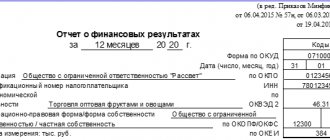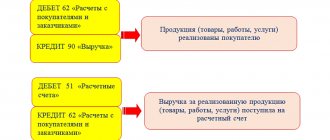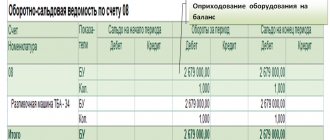Every business has assets. These are material assets and investments, money that allows the company to engage in core and auxiliary activities. Account 58. Financial investments is an item that is needed to reflect in the accounting records the enterprise’s financial investments in securities of various types, make contributions to the company’s capital, issue interest-bearing loans and carry out other operations.
More details about transactions using account 58 will be discussed in the article. A real example will be given for novice accountants.
Scope of application
To display information about which funds should be regarded as financial investments, account 58 is used in the chart of accounts.
Structure of Article 58
Through this PBU article you can display:
- government securities;
- municipal central banks;
- bills, bonds of other companies;
- investments in the authorized capital of other companies;
- interest-bearing loans provided to other companies;
- deposit investments;
- receivables received on the basis of assignment of claims.
Financial investments account 58, subaccounts and other items corresponding to the specified item are used.
Important! Investments in a company's own securities cannot be considered financial investments. This does not include bills issued for manufactured products, purchased “jewelry,” or objects of art.
Account characteristics
Financial investments, account 58 is an active accounting account. That is, when the volume of the indicator increases, the operation is formalized as a debit turnover, and the disposal is recorded as a credit turnover. For example, if an organization purchased debt bonds, then the accountant must record the cost of the purchase as a debit to account 58, and when repaying an interest-bearing loan or selling bonds, as a credit.
Order of the Ministry of Finance No. 94n provides for the opening of additional sub-accounts to account 58:
- 58-1 - for accumulating information on purchased units and shares.
- 58-2 - to reflect information on debt securities, both public and private.
- 58-3 - to generate information about interest-bearing loans provided.
- 58-4 - to collect data on deposits under simple partnership agreements.
As we noted earlier, all of a company’s financial investments can be divided into two types: long-term, with a turnover period of more than 12 months, and short-term, with a duration of less than one year.
If the company's activities involve both short-term and long-term financial investments, which account should be used in this situation? In this case, the company’s accounting policy, and then in the accounting itself, should provide for analytical detail on accounting account 58. That is, the company must independently divide financial investments according to their turnover periods and reflect this information in accounting.
What is it for? When preparing annual and interim accounting reports, data on short-term and long-term financial investments are reflected in different lines of the balance sheet. Thus, deposits with a maturity of up to 12 months should be included in line 1240, and investments with a validity period of more than a year should be included in line 1170.
What are the subaccounts?
Account 58 is not used in accounting in its “pure” form. This article acts as the main one, which takes into account data from all existing sub-accounts.
Picture 4. Subaccounts
To separately account for amounts received in different currency units, an enterprise accountant can open sub-accounts:
- 58 1 - statutory contributions, contributions to joint-stock companies;
- 58 2 — investing in securities;
- account 58 3 - loans provided to citizens to companies in any form. It is 58 subaccount 03 that is often used in accounting;
- 58 4 - contributions to common property under a simple partnership agreement.
On a note! The number of subaccounts is not limited to those indicated, since it is necessary to maintain analytical accounting for each group of objects. An accountant can open additional sub-accounts if this is specified in the company's accounting policies. The most commonly used count is 58 03.
Examples of accounting for financial investments in account 58 with postings
Example 1
Let's consider an example of paying for a share in the authorized capital by transferring a previously used fixed asset. If the market price is determined including VAT.
Let’s assume that the organization, the sole founder of an LLC, paid for its share in the authorized capital of the LLC with used equipment. The market price of the equipment was carried out by an independent appraiser and approved by the LLC participants.
The table shows the source data of the example:
| OS object name | Initial cost, rub. | Amount of depreciation, rub. | Market price including VAT, rub. |
| Metal lathe | 375000 | 41 250 | 318 000 |
| Vertical milling machine for metal | 296000 | 32 560 | 251 000 |
| Total | 671000 | 73 810 | 569 000 |
It is important to know that the transfer of property, including a fixed asset, in payment for a share in the authorized capital is not recognized as a sale, therefore, an object of VAT taxation does not arise with such a transfer.
The following transactions were generated for account 58:
| Dt | CT | Amount, rub. | Wiring Description | Document |
| 58-1 | 76 | 569000 | Cost of financial investment including VAT | LLC establishment agreement, The decision of the participants to evaluate the non-monetary contribution, Certificate of state registration of LLC |
| 02 | 01 | 73810 | Accrued depreciation on equipment written off | Certificate of acceptance and transfer of OS |
| 76 | 01 | 597190 | The residual value of the equipment was written off (671,000-73,810) | Certificate of acceptance and transfer of OS |
| 19 | 68 | 107512 | VAT has been restored in proportion to the residual value of the equipment ((671000-73810)*18%) | Accounting certificate calculation; The restored amount of VAT is indicated as a separate line in the Certificate of Acceptance and Transfer of Assets; When transferring property to the authorized capital of the Tax Code of the Russian Federation, it does not provide for the obligation for the transferring party to draw up an invoice for the amount of restored VAT |
| 76 | 19 | 107512 | The amount of restored VAT is included in calculations for the transfer of property, since the market price is determined taking into account VAT | Accounting certificate calculation |
| 91 | 76 | 135702 | Other expenses are recognized in the form of the difference between the residual value of fixed assets + restored VAT and the cost of fixed assets established by an independent appraiser (671000-73810+107512)-569000=135 702 | Accounting certificate calculation |
Example 2
Let's consider an example of paying for a share in the authorized capital by transferring a previously used fixed asset. If the market price is determined without VAT.
Let’s assume that the organization, the sole founder of an LLC, paid for its share in the authorized capital of the LLC with used equipment. The market price of the equipment was carried out by an independent appraiser and approved by the LLC participants.
The table shows data for the example:
| OS object name | Initial cost, rub. | Amount of depreciation, rub. | Market price excluding VAT, rub. |
| Metal lathe | 375 000 | 41 250 | 269 492 |
| Vertical milling machine for metal | 296 000 | 32 560 | 212 712 |
| Total | 671 000 | 73 810 | 482 204 |
The following transactions were generated for account 58:
| Dt | CT | Amount, rub. | Wiring Description | Document |
| 58-1 | 76 | 482204 | The value of the financial investment was determined by an independent appraiser excluding VAT | LLC establishment agreement, The decision of the participants to evaluate the non-monetary contribution, Certificate of state registration of LLC |
| 02 | 01 | 73810 | Accrued depreciation written off | Certificate of acceptance and transfer of OS |
| 76 | 01 | 597190 | The residual value of the equipment is written off (671000-73810) | Certificate of acceptance and transfer of OS |
| 19 | 68 | 107512 | VAT has been restored in proportion to the residual value of the equipment ((671000-73810)*18%) | Accounting certificate calculation; The restored VAT amount is indicated as a separate line in the Certificate of Acceptance and Transfer of Assets When transferring property to the authorized capital, the Tax Code of the Russian Federation does not provide for the obligation for the transferring party to draw up an invoice for the amount of the restored VAT. |
| 58 | 19 | 107512 | Recovered VAT is charged to the increase in the initial cost of the financial investment, since the market value is determined without taking into account VAT | Accounting certificate calculation |
| 91 | 76 | 114986 | Other expenses are recognized in the form of the difference between the residual value of fixed assets and the cost of fixed assets established by an independent appraiser (671000-73810)-482204=114986 | Accounting certificate calculation |
Example 3
Let's look at the postings to account 58 when selling shares.
Let’s assume that an organization has investments in registered uncertificated shares of Adrenaline Bank in the amount of 2,200,000 rubles on account 58-1. in the amount of 600,000 pieces with a denomination of 1 ruble. The organization sold these shares for the amount of RUB 3,100,000.
The organization’s accounting should reflect the following entries in account 58 when selling shares:
| Dt | CT | Amount, rub. | Wiring Description | Document |
| 76 | 91.01 | 3 100 000 | Other income from sale of shares recognized | Share purchase agreement |
| 91.02 | 58.01 | 2 200 000 | The cost of shares sold is written off | Accounting register data for account 58.01 |
| 51 | 76 | 3 100 000 | Receipt of cash for sold shares | Bank statement |
How does Article 58 correspond to other accounts?
In addition to the main characteristics of the article, it is worth having an idea of which accounting accounts it corresponds with.
There are several accounts that enter into a “relationship” with the 58th account in debit and credit. We are talking about the following articles.
| Debit | Credit |
| 50, 51, 52, 75, 76, 80, 91, 98 | 51, 52, 76, 80, 90, 91,99 |
The main purpose of account 58 is to collect and summarize data on invested funds and other assets of the company in profitable activities.
Definition and classification of documents giving the right to a share in capital
By this category, experts mean monetary documents that confirm the right to own capital or indicate the nature of the relationship between the owner of the document and its issuer.
The functions of such monetary documents as an object of market relations are as follows:
- mobilization of savings of individuals and free resources of enterprises to cover expenses;
- regulation of money circulation;
- acting as a source of investment designed to create new companies or develop existing ones;
- fulfilling the role of a credit settlement instrument;
- redistribution of funds between industries and sectors of the economy;
- granting the right to capital;
- transfer of rights to manage the company;
- acting as a source of income.
In world practice, all existing financial instruments are divided into basic and derivative financial instruments or derivatives. In the first case, we are talking about documents based on the property right to a certain asset.
If we are talking about derivatives, then in this case we are talking about a non-documentary form of right to property that appears due to a change in the value of the financial instrument that underlies it.
If we take the form of issue as a basis, then we can distinguish issue-grade securities, for example, shares, and non-issue securities, for example, checks and bills.
If we classify documents according to the order of ownership, then we should distinguish between registered, warrant and bearer papers.
In practice, there are many other criteria by which designated monetary settlement documents can be classified.
Posting account 58 in accounting
The PUB also shows the transactions used to display all operations using account 58. Let's look at the transactions for account 58 in more detail in the table:
| Operation description | Debit | Credit |
| The securities were purchased for foreign currency. | 58-1 | 52 |
| The bonds were paid from a current ruble account. | 58-2 | 51 |
| The loan was issued to another company with materials. | 58-3 | 10 |
| Under a simple partnership agreement, the fixed asset was transferred as a contribution to the management company. | 58-4 | 1 |
| The difference between the initial cost of the bond and the current market price was included in the financial results. | 58-2 | 91 |
| Revaluation of shares at market value as of the current date. | 91 | 58-1 |
| Payment on a bill. | 51 | 58-2 |
| The previously issued loan was returned by bank transfer. | 51 | 58-3 |
| The intangible asset transferred under a simple partnership agreement was returned. | 4 | 58-4 |
The presented entries were compiled using not the main financial investment account, but sub-accounts opened in the accounting of the enterprise. In the table presented, the debit of account 58 shows that the assets of the enterprise were transferred to another organization, and the passive position of the sub-accounts reflects the assets received by the company.
On a note! Every accountant must know that account 58 in the balance sheet is indicated on lines 1170 and 1240.
Topic 8. ACCOUNTING FOR CASH AND FINANCIAL INVESTMENTS
8.5. Accounting for financial investments
Financial investments include:
1) investments of an enterprise in the authorized capitals of other organizations;
2) state and municipal securities, securities of other enterprises (bonds, bills);
3) loans provided to other enterprises on the territory of the Russian Federation and abroad;
4) deposits;
5) receivables acquired on the basis of assignment of the right of claim;
6) contributions of the partner organization under a simple partnership agreement.
Accounting is regulated by PBU 19/02 dated December 27, 2002 “Accounting for financial investments.”
To accept assets for accounting as financial investments, the following conditions must be simultaneously met:
§ availability of properly executed documents confirming the existence of the organization’s right to financial investments and to receive funds or other assets;
§ transition to organizing financial risks associated with financial investments (risk of price changes, risk of debtor insolvency, liquidity risk, etc.);
§ the ability to bring economic benefits to the organization in the future in the form of interest, dividends, or an increase in their value (in the form of the difference between the sale price of a financial investment and its purchase value, as a result of its exchange, use in repaying obligations, an increase in the current market value).
Financial investments are divided into long-term
(for a period of more than one year) and
short-term
(for a period of less than one year). Financial investments are accepted for accounting at their original cost (in the amount of actual costs for the investor).
For synthetic accounting, active account 58 “Financial investments” is used.
Sub-accounts can be opened: 58-1 “Units and shares”, 58-2 “Debt securities”, 58-3 “Provided loans”, 58-4 “Deposits under a simple partnership agreement”, etc.
Analytical accounting of financial investments is carried out in such a way as to provide information on the units of accounting for financial investments and the organizations in which these investments are made (issuers of securities, other organizations in which the enterprise is a participant, borrowing organizations, etc.).
securities accepted for accounting
other organizations, analytical accounting must contain at least the following information:
— name of the issuer and name of the security, number, series, etc.,
- nominal price, purchase price, costs associated with their acquisition,
— date of purchase, date of sale or other disposal, storage location.
For the purposes of subsequent assessment, financial investments are divided into two groups:
1) financial investments for which the current market value can be determined are reflected in the financial statements at the end of the reporting year at the current market value by adjusting their valuation as of the previous reporting date. This adjustment can be made monthly or quarterly. The difference between the valuation of financial investments at the current market value as of the reporting date and the previous valuation of financial investments is included in financial results (as part of operating income or expenses).
2) financial investments for which the current market value is not determined are subject to reflection in accounting and reporting as of the reporting date at their original cost.
For debt securities for which the current market value is not determined, the organization is allowed to attribute the difference between the initial cost and the nominal value during the period of their circulation evenly as income due on them in accordance with the terms of issue to financial results.
To the actual costs of purchasing securities
relate:
- amounts paid in accordance with the contract to the seller;
— amounts paid to specialized organizations for information and consulting services related to the acquisition of securities;
— remunerations paid to intermediary organizations with the participation of which securities were purchased (credit organizations, brokers) and other expenses.
The following entries are made in accounting for the amount of costs incurred:
D 58 K 60, 76 – for the amount of debt to pay the actual costs of purchasing securities;
D 60, 76 K 51, 50, 52 – when paying for the cost of securities in cash;
D 60, 76 K 62 – when paying for purchased securities with finished products or goods, materials;
D 76 K 50, 51 – when paying for information and consulting services related to the acquisition of securities, remuneration to intermediary organizations, etc.
Securities can be obtained:
o as a contribution to the authorized capital at the cost specified in the constituent documents: D 58 K 75;
o can apply free of charge: D 58 K 91.
Redemption (redemption) and sale of securities are reflected by the entry:
D 91 K 58 (except for organizations that reflect these transactions on account 90).
According to their form, deposits
are divided into deposits in cash and deposits in property transferred by the participant (founder) to repay his obligations under the deposit. When carrying out operations on contributions to the authorized (share) capital of other organizations, the following entries are made in the investor’s accounting:
D 58 sub-account “Units and shares” K 50, 51, 52 – when transferring funds to the authorized (share) capital of the organization in the amount according to the constituent documents;
D 58-1 K 01, 04, 10, 20, 23, 41, 43 – when transferring the organization’s property as a contribution to the authorized (share) capital.
In this case, the difference between the valuation of the deposit reflected in account 58 and the value of the transferred property is reflected in credit 91 (as operating income) or debit 91 (as operating expense);
Posting examples
The final paragraph provides a specific example of using postings with subaccounts 58 accounts for beginners. The Cactus company sells exotic plants.
Example of a balance sheet for account 58
During the first quarter of this year, the company bought shares for 10 thousand dollars and issued a loan to another company that supplies them with turf for infrastructure development in the amount of 200 thousand rubles. At the end of the reporting period, the loan was returned to the current account. The accountant revalued the shares, with an increase of 10% at the market rate. Let's create the entries that the accountant of the Cactus company must make.
- Dt. 58-1 - Kt.52 - $10,000 - shares purchased for foreign currency.
- Dt. 58-3 - Kt.51 - 200,000 rubles - loan to another company engaged in the supply of turf.
- Dt. 91—Kt. 58-1 - $1000 - revaluation of shares with an increase of 10%.
- Dt. 51—Kt. 58-3 - 220,000 rubles - loan repayment with interest.
In conclusion, Article 58 is used mainly by companies that work closely with third parties and often make various financial investments. The accounting department keeps records of open sub-accounts, and the final indicators are formed on the main account - 58.
https://www.youtube.com/watch?v=eRVeCaNt6hs
Wiring cannot be done: D 60 K 58
Financial investments"
58.1 - "Units and shares";
58.2 - “Debt securities”;
58.3 - “Loans provided”;
58.4 - “Deposits under a simple partnership agreement”, etc.
UNIT - a share of the capital of a company, which gives the right to participate in general meetings of shareholders, to receive dividends and part of the company’s property upon its liquidation. P. is expressed in a specific document - a certificate, to which coupons for receiving dividends are attached.
SHARES are securities issued by a joint-stock company, the owners of which are granted all property and personal rights associated with the ownership of a share: a) the right to receive dividends, depending on the size of the corporation’s profit; b) the right to participate in the management of the corporation by voting at meetings; c) the right to receive part of the property after the liquidation of the corporation. Rights are exercised in an amount proportional to the size of the shares.
D 58 K 51 – reflects the emergence of a financial investment object (when transferring or paying for this object from a current account);
D 58 K 76 – reflects the occurrence of debt to counterparties (if payment for financial investment objects will be made after obtaining ownership rights to them, for example, in the case of securities).
D 76 K 91 —
D 91 K 58 – reflects the negative difference between the purchase and par value (or between the par and purchase value) of the acquired debt securities.
In account 58, investments are accounted for at actual cost (in the amount of costs incurred for their acquisition).
Financial investments are the second most liquid after cash in hand and in current accounts.
Account 59 “Reserves for the impairment of financial investments” is intended to summarize information on the availability and movement of reserves for the impairment of the organization’s financial investments.
The reserve is formed at the expense of financial results (as part of operating expenses), which is reflected in the accounting entry as a debit to account 91 “Other income and expenses” and a credit to account 59 “Provisions for impairment of financial investments.” A similar entry is made when increasing reserves in the event of a further decrease in the estimated value of financial investments.
The reserve is reduced (used) in the following cases: if the estimated value of the relevant assets in the reporting period has increased, if their value is no longer subject to a sustained significant decrease, as well as upon disposal of these assets. In this case, an entry is made in the debit of account 59 “Provisions for impairment of financial investments” in correspondence with the credit of account 91 “Other income and expenses”.
In the financial statements, financial investments for which an impairment reserve has been created are reflected at their book value less the amount of the reserve. In the net balance sheet, when reflected in the asset, the difference between 58 and 59 accounts is reflected. Those. There is no account in the liabilities side of balance 59!
Reserve for depreciation of financial investments” (passive, contractual to account 58).
If we have a large number of shares of one company, and its shares have sharply decreased in price, we cannot reflect these changes in account 58, because this will lead to misstatement of the financial statements.
The reserve for impairment of financial investments is created by the following entry:
D 91.2 K 59
D 59 K 91.2 – reserve amount restored
As soon as financial investments are disposed of, the corresponding reserve amounts are written off to other income of the enterprise (91.1).
Regulatory regulation of the accounting of bills of exchange is carried out by the “Regulations on promissory notes and bills of exchange” dated August 7, 1937.
When purchasing bills of exchange, they are accounted for at actual cost on account 58, disposal is reflected through account 91.
D 60 K 91 – we pay with a bill of exchange with the supplier.
If we purchased a bill with a face value of 1000 rubles, and with a discount it was transferred to us for actually 900 rubles, then we will reflect the acquisition price in accounting - 900 rubles.
Upon disposal of this bill, we will make the following entries:
D 60, 76 K 91.1 1000
D91.2 K 58 900
A credit balance of 100 rubles is formed, and income tax is paid on it.
If we provide a loan, we make the following entries:
D 58 K 51
If our main activity is the purchase and sale of financial investments, then income and expenses are charged to account 90, otherwise - to account 91.
When transferring shares, bills, i.e. When they are disposed of and sold, the following entry is made:
D 90.1, 91.2 K 58
Wiring cannot be done: D 60 K 58
D 76 K 91.1 – interest accrued on loans is reflected;
If the loan is provided to an employee, then interest will be accrued to account 73.
D 73 K 91.1
If we have been accrued dividends on the objects of any financial investments, then we will reflect their receipt by posting:
D 51 K 91.1
58.4 - “Deposits under a simple partnership agreement” (joint activities of enterprises, which are kept on the books of one of the enterprises);
When depositing assets, account 58 is used.
Under the simple partnership agreement, funds were deposited from the current account:
Accounting account 58 is the active “Financial Investments” account. On synthetic account 58, accounting of the organization's investments is organized. Using standard postings and practical examples, we will study the specifics of using account 58 and the features of reflecting transactions for accounting for financial investments.
Tax obligations have arisen - reflect them in accounting
“Our organization, according to its accounting policy, reflects revenue on an accrual basis. In practice, business transactions arise that involve issuing loans to other organizations.
The interest received in this case raises questions both regarding the order of reflection in accounting and at the moment of recognition of income in tax accounting. I believe that these questions are of interest to many, especially since they are related to the use of the new standard chart of accounts...” So, your organization provided a loan to another organization on a reimbursable basis. In accounting, such a business transaction, depending on the term of the loan, should be reflected in the following entry: For reference: on account 06 loans granted to other organizations (for a period of more than 12 months) should be reflected, on account 58 - loans provided to organizations for a period of less than 12 months.
Active and passive accounting accounts - table and explanations
The list of active and passive accounts is established by the Chart of Accounts, approved by the Ministry of Finance of the Russian Federation in 2000.
Accounting accounts are divided into 3 groups:
A complete chart of accounts without division into types can be seen on the Chart of Accounts page.
Types of accounts on the balance sheet
In the annual balance sheet, the totals of the accounts are reflected in assets and liabilities, depending on their type.
Active accounts
Such accounts include those whose initial and final balances are necessarily debit; an increase in turnover also occurs according to Dt. If this rule is not followed, then there is an error in accounting. It is worth noting that in all accounting programs you can set a limit that does not allow you to write off more than what was received in total terms.
The active group includes accounts that reflect the assets of the enterprise, that is, the organization’s property and external debts.
The organization's assets are divided by type:
- material (inventory, property, etc.);
- monetary;
- expensive;
- distribution;
- current accounts.
For active accounts, income (receipt) is always taken into account according to Dt, and disposal, reduction - according to Kt.
As the simplest example, we can consider accounting account 50 “Cash”.
At the Blue Pines boarding house, cash revenue of 38,000 rubles was received for the provision of a tennis court and car parking. On the same day, the client was refunded the amount of overpayment for renting a room in a residential building, since the client left a day earlier - in the amount of 4,000 rubles.
And at the end of the day, the balance of funds, with the exception of the approved cash balance limit, was transferred from the cash register to the current account.
| Dt | CT | Operation description | Sum | Document |
| 51 | 80 | Contribution to the authorized capital has been transferred | 10000 | Payment order in. |
List of passive accounts
Active-passive accounts
Accounts that combine the characteristics of active and passive are called active-passive. In accounts of this type, the balance can be either debit or credit. Such accounts reflect transactions for settlements with counterparties (suppliers and buyers, accountable persons), the budget (for taxes and duties), etc.
As an example, you can take transactions on account 60. Counterparties - suppliers - can be both debtors and creditors in relation to the organization.
Let's say Avesta LLC ordered a shipment of equipment from a retailer in the amount of 118,000 (including VAT - 18,000). The contract stipulates that the goods will be delivered only after 50% prepayment.
After Avesta transferred the advance payment, the goods were shipped in full.
| ACTIVE ACCOUNTS OF THE CHART OF ACCOUNTS | ||
| CODE | ACCOUNT NAME | ACCOUNT TYPE |
| 01 | Account 01 “Fixed Assets” | ACTIVE |
| 03 | Account 03 “Profitable investments in material assets” | ACTIVE |
| 04 | Account 04 “Intangible assets” | ACTIVE |
| 08 | Account 08 “Investments in non-current assets” | ACTIVE |
| 09 | Account 09 “Deferred tax assets” | ACTIVE |
| 10 | Account 10 “Materials” | ACTIVE |
| 19 | Account 19 “VAT on purchased assets” | ACTIVE |
| 20 | Account 20 “Main production” | ACTIVE |
| 23 | Account 23 “Auxiliary proceedings” | ACTIVE |
| 25 | Account 25 “General production expenses” | ACTIVE |
| 26 | Account 26 “General business expenses” | ACTIVE |
| 29 | Account 29 “Servicing industries and farms” | ACTIVE |
| 41 | Account 41 “Goods” | ACTIVE |
| 43 | Account 43 “Finished products” | ACTIVE |
| 44 | Account 44 “Sales expenses” | ACTIVE |
| 45 | Account 45 “Goods shipped” | ACTIVE |
| 50 | Account 50 “Cashier” | ACTIVE |
| 51 | Account 51 “Current accounts” | ACTIVE |
| 52 | Account 52 “Currency accounts” | ACTIVE |
| 58 | Account 58 “Financial investments” | ACTIVE |
| 97 | Account 97 “Deferred expenses” | ACTIVE |
Structure of active accounts
Active accounting accounts have a balance (balance) at the beginning of the period or its end only by debit.
The credit of the active account reflects transactions related to the consumption of material (current) inventories of the enterprise, cash or a decrease in the value of non-current assets.
They increase according to the debit of the active account.
The balance of active accounts can only be debit.
It is calculated using the formula:
Balance at the end of the period = Balance at the beginning + Debit turnover – Credit turnover.
The balance is reflected in the balance sheet, in its active part, and indicates the actual availability of a material resource in monetary terms.
Still have questions about accounting and taxes? Ask them on the accounting forum.
Interest-free loan in 1C 8.3
An interest-free loan should be considered separately, because its implementation in 1C 8.3 is significantly different from an interest-bearing loan. Distinctive features of the issued interest-free loan in comparison with interest-bearing ones are:
- The issued interest-free loan is not a financial investment
- When receiving an interest-free loan, the recipient receives material benefits from saving on interest
An interest-free loan is not a financial investment for the issuing party, because one of the mandatory conditions for recognizing a financial investment is not met, namely, the condition for receiving income from such an investment (according to paragraph 2 of paragraph 1 of Order of the Ministry of Finance of Russia dated December 10, 2002 N 126n “On approval of the Accounting Regulations “Accounting for Financial Investments” PBU 19/02″, see ConsultantPlus).
The material benefit from saving on interest on the loan received arises in accordance with). If an organization (or entrepreneur) issues an interest-free loan to an individual, then it has the responsibilities of a tax agent for personal income tax (NDFL) in relation to the material benefit of the individual.
Let's look at how these two conditions will affect an interest-free loan in 1C Accounting 8.3
An interest-free loan was issued - how to reflect this in transactions
However, a loan issued in cash may also be interest-free (Articles 809, 810 of the Civil Code of the Russian Federation). In such a situation, it loses the main feature (the ability to generate income), which allows it to be included in financial investments. How to show the borrower's debt in this case? It should be reflected as a regular debt of the counterparty for settlements not related to sales to him, i.e. using account 76.
Depending on whether the transfer of funds issued as a loan is made in rubles or in foreign currency, the entry - a loan was issued to another organization - without interest will take the form Dt 76 Kt 51 or Dt 76 Kt 52.
Since accrual of income is not provided, records of transactions for recording interest and for their payment will not appear. That is, until the debt is repaid, its amount will be listed in the debit of account 76. The return will be reflected by the reverse entry to the one with which the debt was registered: Dt 51 (52) Kt 76.
Thus, in a situation where another organization has been issued an interest-free loan, the entries for it will only reflect its occurrence in accounting and write-off when the funds are returned.










